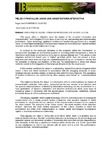| dc.contributor.author | Fernández-Álvarez, Ángel J. | |
| dc.date.accessioned | 2024-01-22T17:18:55Z | |
| dc.date.available | 2024-01-22T17:18:55Z | |
| dc.date.issued | 2010 | |
| dc.identifier.citation | Fernández-Álvarez, Ángel José (2010). Pieles y pantallas. Hacia una arquitectura interactiva. En Actas XIII Congreso Internación de Expresión Gráfica Arquitectónica (Vol. 1, pp. 171-176). Universitat Politècnica de València. | es_ES |
| dc.identifier.isbn | 978-84-8363-550-6 | |
| dc.identifier.uri | http://hdl.handle.net/2183/35058 | |
| dc.description | Versión aceptada da ponencia presentada en el XIII congreso Internacional de Expresión Gráfica Arquitectónica organizado por el Departamento de Expresión Gráfica Arquitectónica de la E.T.S. de Arquitectura de Valencia del 27 a 29 de mayo de 2010.
Autorización para el depósito de la ponencia en el repositorio concedida por la Editorial Universitat Politècnica de València. | es_ES |
| dc.description.abstract | [Abstract]: This paper offers a reflection upon the impact of the so-called Information and Communication Technologies (ITC) on ways of carrying out, representing and understanding architecture. Digital technology applied to architecture enables the generation of a complex formal universe approximating architectural space based on multidisciplinary experimentation favoured by the use of information technology.
In contrast to the traditional utilisation of the computer within the “mechanical” or “perspectivist” paradigm an architectural practice is extending which incorporates a vision of information technology as something more than a representational tool. Thus arises a new imaginary architecture based upon a “digital” paradigm which does not present a linear sequence and which does not imply at a spatial/temporal fixing but is based on velocity and the possibility of change and mutation. In this way the characteristics of these new design methods consist in the integration of the temporal dimension into the creative act.
In this context, architectural research is advancing toward the ideation of spaces which evolve in time and which transform in accordance with the changing demands of users. Buildings become sensitive entities (e-motives) with which the body interacts. The paradigms of modern architecture are substituted by other new(er) ones based on communicational logic.
The digital transforms the object into information able to extend globally by means of communication networks. Information, understood as the raw material of architecture, and the dynamic interconnections facilitated by information technology are the nourishment for a “new generation” of dynamic, interactive and sensitive architectures which pose ways of occupying space in coherence with the psychological, morphological, intellectual, cultural and social demands of the contemporary individual.
The display capability which digital technology offers to architecture and its consequent transformation into a media product fosters metaphoric and narrative aspects in which architecture is transformed into an interface of the communicative structure of the media in the urban context. The metaphor of the “urban screen”, the latest evolution of the Albertian window becomes the most evident expression of this cultural situation in which the architectural act shifts from materialisation to display whilst technological hybridization implies a new body-architecture relationship.
Thus appears an index of “living and smart skins” which react in a sensitive way to external stimuli offering a “flexible” connection between the building and its surroundings and expanded spaces are generated capable of interacting with users and not just responding to their demands. In this way a reactive architecture arises whose aim is to furnish space with its own intelligence so that it may interact with its users and in which “the performative” becomes the new, dominant paradigm. | es_ES |
| dc.language.iso | spa | es_ES |
| dc.publisher | Universitat Politècnica de València | es_ES |
| dc.rights | © de la presente edición: Editorial Universitat Politècnica de València. Autorización para el depósito de la ponencia en el repositorio concedida por la Editorial Universitat Politècnica de València. | es_ES |
| dc.title | Pieles y pantallas. Hacia una arquitectura interactiva | es_ES |
| dc.title.alternative | Skins and screens. Towards an interactive architecture | es_ES |
| dc.type | info:eu-repo/semantics/conferenceObject | es_ES |
| dc.type | info:eu-repo/semantics/conferenceObject | es_ES |
| dc.rights.access | info:eu-repo/semantics/openAccess | es_ES |
| UDC.volume | 1 | es_ES |
| UDC.startPage | 171 | es_ES |
| UDC.endPage | 176 | es_ES |
| UDC.conferenceTitle | XIII Congreso Internacional de Expresión Gráfica Arquitectónica | es_ES |






